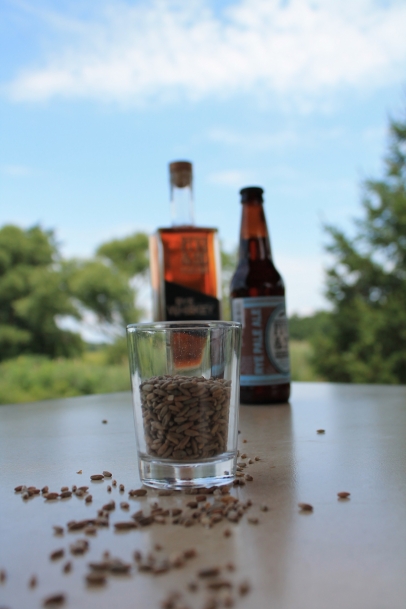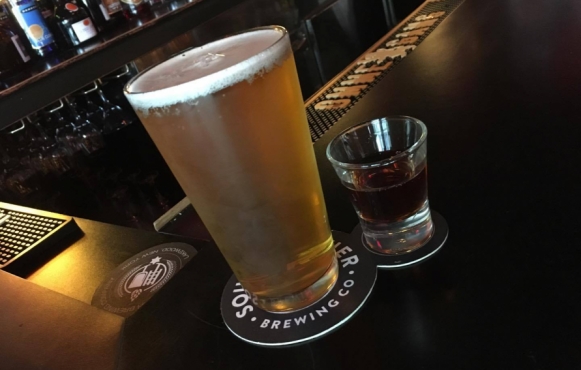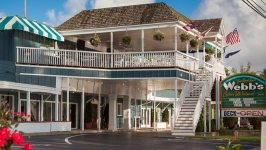Blending Booze & Beer: A Classic Combination Made New Again with Locally Made Spirits and Microbrew

Beer and booze can be the best of friends when paired in the right combinations.
Some people are surely cringing after reading that first sentence.
"Beer and booze? Together!? One wicked hangover in college was enough for me! Never again!"
There's still a stigma attached to the classic combination of a shot-and-a-beer, despite it being a fairly common order at most bars in America.
At Forte the Restaurant, where I work in Jamestown, NY, we saw an opportunity a few years back to highlight our growing selection of craft beer by printing out a "Suggested Pairing" menu of microbrew and our top shelf spirits. See how much better that sounds? Craft beer and quality spirits, not just beer and booze.
Moreover, the combinations we suggested weren't for slamming back, and we even stipulated that fact on our menu. Much in the same way that nosing and tasting wine is revered, we encouraged our customers to actually stop and contemplate the Southern Tier Brewing Company's 2X Milk Stout in tandem with an ounce of The Balvenie's Doublewood 12-year Scotch.
Not a far cry from a Guinness and Jameson, we know. But that first iteration of our pairing menu led to further exploration of our stock, and soon we had a dozen side-by-side pairings as well as mixed drinks of sorts — with liquor in the beer. Call it a Boilermaker, call it a Depth Charge, call it whatever you will, but for us the addition of an ounce of malty-sweet Irish whiskey into a pint of Southern Tier's Harvest, a bitter fall seasonal beer, somehow made one plus one taste like three. The duo became more than the sum of its parts.
Flash forward several years and we're now seeing with craft spirits what we saw with microbrew so many years ago — and with this uptick in new products comes curious consumers who want to know how they should go about imbibing the stuff.
We're not purists at Forte. We're people-pleasers. There's no drink shaming and we never fault anyone for wanting their liquor prepared in a certain way — neat, on ice, with mixer or even in a beer. Thankfully we're not alone in this regard.
At the Enchanted Mountain Spirits in Jamestown, distiller Mick O'Neill and colleague John Fisk currently only serve two spirits: their potato vodka and Poteen (pronounced puh-cheen), which is an Irish potato moonshine of sorts. With just two spirits in house, the cocktails at Enchanted Mountain have to be vessels to truly show off the products — which keeps O'Neill and Fisk constantly working on new mixers, recipes and ways to showcase their juice.
In the spring or summer, my beer-and-shot suggestions would look much different — with pairings like genever and a tasty pilsner, or Southern Tier Distilling Company's citrus gin with a flavored summer wheat. But fall is a time of transition, and the way we drink in Western New York reflects that. It's not yet time for hearty stouts and whiskies.
Similarly, fall is when craft beer and craft spirit makers in the region are able to capitalize on some of this area's native flavors. Take for instance the cinnamon apple amber ale which is out now from the Big Ditch Brewing Company in Buffalo. The seasonal special release is brewed with local malts, local apple cider, oatmeal, brown sugar, cinnamon and allspice.
"Its aroma will remind you of fall," said Big Ditch sales rep Andrew MacDonald. "Upon sipping you will taste spice, a rich malty base and a subtle tangy apple finish. The hops add just enough bitterness to keep this spiced fruit beer very much a beer."
Though they don't serve shots at their tasting room, MacDonald mentioned a few liquors which would work well with this brew — like the cinnamon-flavored Fireball or a quaff of some home brew apple pie moonshine. For my pairing, I went with a liqueur from Rochester's Black Button Distilling Company.
Though he works at a brewery, MacDonald said he could see a correlation between beer and liquor when I asked him about their interrelatedness.
"I do see a commonality between brewing and distilling. In order to distill good liquor, you need to first make some good beer," MacDonald said. "Brewers and distillers are working with very similar ingredients, they both work with and depend on yeast strains, and they are trying to create an enjoyable flavor in their crafted beverage."







